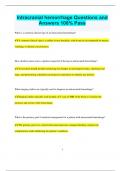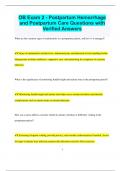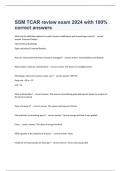Hemorrhage - Study guides, Revision notes & Summaries
Looking for the best study guides, study notes and summaries about Hemorrhage? On this page you'll find 31436 study documents about Hemorrhage.
Page 2 out of 31.436 results
Sort by

-
Postpartum Hemorrhage Latest Update Graded A+
- Exam (elaborations) • 15 pages • 2024
- Available in package deal
-
- £8.17
- + learn more
Postpartum Hemorrhage Latest Update Graded A+ What are the initial steps a nurse should take when postpartum hemorrhage is suspected? The initial steps include assessing the amount of bleeding, performing uterine massage, administering uterotonics, and monitoring vital signs closely. How can a nurse support a patient’s emotional well-being during a postpartum hemorrhage event? Support emotional well-being by providing reassurance, offering clear explanations about the situation...

-
Intracranial hemorrhage Questions and Answers 100% Pass
- Exam (elaborations) • 17 pages • 2024
- Available in package deal
-
- £8.17
- + learn more
Intracranial hemorrhage Questions and Answers 100% Pass What is a common clinical sign of an intracranial hemorrhage? A common clinical sign is a sudden severe headache, which may be accompanied by nausea, vomiting, or altered consciousness. How should a nurse assess a patient suspected of having an intracranial hemorrhage? Assessment should include monitoring for changes in neurological status, checking vital signs, and performing a detailed neurological examination to identify any...

-
Postpartum Hemorrhage Practice Questions Test 4 Latest Update Graded A+
- Exam (elaborations) • 21 pages • 2024
- Available in package deal
-
- £8.17
- + learn more
Postpartum Hemorrhage Practice Questions Test 4 Latest Update Graded A+ What is the primary cause of early postpartum hemorrhage? - A) Uterine atony - B) Placental abruption - C) Lacerations - D) Retained placenta A) Uterine atony *Rationale:* Uterine atony, or failure of the uterus to contract effectively after delivery, is the most common cause of early postpartum hemorrhage. How should a nurse respond if a patient exhibits signs of postpartum hemorrhage within the first 24...

-
Postpartum Hemorrhage Questions and Answers Already Passed
- Exam (elaborations) • 17 pages • 2024
- Available in package deal
-
- £8.17
- + learn more
Postpartum Hemorrhage Questions and Answers Already Passed What are the primary causes of postpartum hemorrhage, and how should each be managed? The primary causes of postpartum hemorrhage include uterine atony, retained placenta, vaginal or cervical lacerations, and coagulation disorders. Management involves uterine massage and oxytocin for uterine atony, manual removal or surgical intervention for retained placenta, repair of lacerations, and treatment of coagulation disorders wit...

-
Hemorrhage Volume 4 Chapter 3 Latest Update Graded A+
- Exam (elaborations) • 15 pages • 2024
- Available in package deal
-
- £8.17
- + learn more
Hemorrhage Volume 4 Chapter 3 Latest Update Graded A+ What is the primary goal of immediate treatment for a patient experiencing hemorrhage? The primary goal is to control bleeding, stabilize the patient’s condition, and prevent shock or further complications. How should a nurse assess for signs of internal bleeding in a patient? Assess for signs such as abdominal pain, swelling, bruising, and changes in vital signs like decreased blood pressure or increased heart rate. What is...

-
OB Exam 2 - Postpartum Hemorrhage and Postpartum Care Questions with Verified Answers
- Exam (elaborations) • 34 pages • 2024
- Available in package deal
-
- £8.58
- + learn more
OB Exam 2 - Postpartum Hemorrhage and Postpartum Care Questions with Verified Answers What are the common signs of endometritis in a postpartum patient, and how is it managed? Signs of endometritis include fever, abdominal pain, and abnormal or foul-smelling lochia. Management includes antibiotics, supportive care, and monitoring for symptoms of systemic infection. What is the significance of monitoring fundal height and uterine tone in the postpartum period? Monitoring funda...

-
OSCE: Postpartum Hemorrhage Questions and Answers 100% Pass
- Exam (elaborations) • 14 pages • 2024
- Available in package deal
-
- £8.17
- + learn more
OSCE: Postpartum Hemorrhage Questions and Answers 100% Pass What is postpartum hemorrhage defined as? Postpartum hemorrhage is defined as blood loss greater than 500 ml following a vaginal delivery or greater than 1000 ml following a cesarean section. What are common causes of early postpartum hemorrhage? Common causes of early postpartum hemorrhage include uterine atony, retained placenta, and vaginal or cervical tears. How should uterine atony be managed in a case of postpa...

-
Acute Gastrointestinal Hemorrhage Questions and Answers 100% Pass
- Exam (elaborations) • 15 pages • 2024
- Available in package deal
-
- £8.17
- + learn more
Acute Gastrointestinal Hemorrhage Questions and Answers 100% Pass What is a common initial symptom of acute gastrointestinal hemorrhage? - A) Chest pain - B) Severe abdominal pain - C) Vomiting blood - D) Fatigue C) Vomiting blood *Rationale:* Vomiting blood, or hematemesis, is a common initial symptom indicating gastrointestinal bleeding. Which diagnostic test is often used to identify the source of gastrointestinal bleeding? - A) Chest X-ray - B) CT scan of the abdomen - C) ...

-
SSM TCAR review exam 2024 with 100% correct answers
- Exam (elaborations) • 25 pages • 2024
-
- £9.39
- 8x sold
- + learn more
What are the definitive options for pelvic fracture stabilization and hemorrhage control? - correct answer External Fixation Interventional Radiology Open reduction & Internal fixation How are closed mid-shaft femur fractures managed? - correct answer Intramedullary nail fixation What makes a fracture comminuted? - correct answer The bone is in multiple pieces Physiologic criteria for trauma center care? - correct answer SBP<90 Resp rate <10 or >29 GCS <14 Wha...

-
GI Hemorrhage Case Study with Complete Solutions
- Exam (elaborations) • 11 pages • 2024
- Available in package deal
-
- £8.17
- + learn more
GI Hemorrhage Case Study with Complete Solutions What initial symptoms might a patient with an upper gastrointestinal hemorrhage present with during a routine clinic visit? Hematemesis (vomiting blood) and melena (black, tarry stools) How might a history of chronic alcohol use contribute to the risk of gastrointestinal hemorrhage? Chronic alcohol use can lead to conditions like esophageal varices or gastritis, increasing the risk of GI bleeding. If a patient presents with a...

Did you know that on average a seller on Stuvia earns £76 per month selling revision notes? Hmm, hint, hint. Discover all about earning on Stuvia


